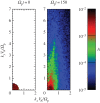Short-wavelength plasma turbulence and temperature anisotropy instabilities: recent computational progress
- PMID: 25848081
- PMCID: PMC4394681
- DOI: 10.1098/rsta.2014.0149
Short-wavelength plasma turbulence and temperature anisotropy instabilities: recent computational progress
Abstract
Plasma turbulence consists of an ensemble of enhanced, broadband electromagnetic fluctuations, typically driven by multi-wave interactions which transfer energy in wavevector space via non- linear cascade processes. Temperature anisotropy instabilities in collisionless plasmas are driven by quasi-linear wave-particle interactions which transfer particle kinetic energy to field fluctuation energy; the resulting enhanced fluctuations are typically narrowband in wavevector magnitude and direction. Whatever their sources, short-wavelength fluctuations are those at which charged particle kinetic, that is, velocity-space, properties are important; these are generally wavelengths of the order of or shorter than the ion inertial length or the thermal ion gyroradius. The purpose of this review is to summarize and interpret recent computational results concerning short-wavelength plasma turbulence, short-wavelength temperature anisotropy instabilities and relationships between the two phenomena.
Keywords: instabilities; simulations; turbulence.
Figures



Similar articles
-
Anisotropy in solar wind plasma turbulence.Philos Trans A Math Phys Eng Sci. 2015 May 13;373(2041):20140152. doi: 10.1098/rsta.2014.0152. Philos Trans A Math Phys Eng Sci. 2015. PMID: 25848082 Free PMC article. Review.
-
Pressure-anisotropy-induced nonlinearities in the kinetic magnetorotational instability.J Plasma Phys. 2017 Dec;83(6):905830613. doi: 10.1017/S0022377817000940. Epub 2017 Dec 18. J Plasma Phys. 2017. PMID: 29657337 Free PMC article.
-
Energy partitioning constraints at kinetic scales in low-β turbulence.Phys Plasmas. 2018;25(2):022303. doi: 10.1063/1.5009158. Epub 2018 Feb 20. Phys Plasmas. 2018. PMID: 30344429 Free PMC article.
-
Magnetorotational Turbulence and Dynamo in a Collisionless Plasma.Phys Rev Lett. 2016 Dec 2;117(23):235101. doi: 10.1103/PhysRevLett.117.235101. Epub 2016 Dec 1. Phys Rev Lett. 2016. PMID: 27982637
-
A dynamical model of plasma turbulence in the solar wind.Philos Trans A Math Phys Eng Sci. 2015 May 13;373(2041):20140145. doi: 10.1098/rsta.2014.0145. Philos Trans A Math Phys Eng Sci. 2015. PMID: 25848075 Free PMC article. Review.
Cited by
-
Dissipation and heating in solar wind turbulence: from the macro to the micro and back again.Philos Trans A Math Phys Eng Sci. 2015 May 13;373(2041):20140155. doi: 10.1098/rsta.2014.0155. Philos Trans A Math Phys Eng Sci. 2015. PMID: 25848077 Free PMC article.
-
Dynamic properties of small-scale solar wind plasma fluctuations.Philos Trans A Math Phys Eng Sci. 2015 May 13;373(2041):20140146. doi: 10.1098/rsta.2014.0146. Philos Trans A Math Phys Eng Sci. 2015. PMID: 25848078 Free PMC article.
-
Anisotropy in solar wind plasma turbulence.Philos Trans A Math Phys Eng Sci. 2015 May 13;373(2041):20140152. doi: 10.1098/rsta.2014.0152. Philos Trans A Math Phys Eng Sci. 2015. PMID: 25848082 Free PMC article. Review.
-
Turbulent reconnection and its implications.Philos Trans A Math Phys Eng Sci. 2015 May 13;373(2041):20140144. doi: 10.1098/rsta.2014.0144. Philos Trans A Math Phys Eng Sci. 2015. PMID: 25848076 Free PMC article. Review.
-
The role of turbulence in coronal heating and solar wind expansion.Philos Trans A Math Phys Eng Sci. 2015 May 13;373(2041):20140148. doi: 10.1098/rsta.2014.0148. Philos Trans A Math Phys Eng Sci. 2015. PMID: 25848083 Free PMC article. Review.
References
-
- Matthaeus WH, Velli M. 2011. Who needs turbulence?: A review of turbulence effects in the heliosphere and on the fundamental process of reconnection. Space Sci. Rev. 160, 145–168. (10.1007/s11214-011-9793-9) - DOI
-
- Shebalin JV, Matthaeus WH, Montgomery D. 1983. Anisotropy in MHD turbulence due to a mean magnetic field. J. Plasma Phys. 29, 525–547. (10.1017/S0022377800000933) - DOI
-
- Karimabadi H, et al. 2013. Coherent structures, intermittent turbulence, and dissipation in high-temperature plasmas. Phys. Plasmas 20, 012303 (10.1063/1.4773205) - DOI
-
- Gary SP. 1993. Theory of space plasma microinstabilities. New York, NY: Cambridge University Press.
Publication types
LinkOut - more resources
Full Text Sources
Other Literature Sources

